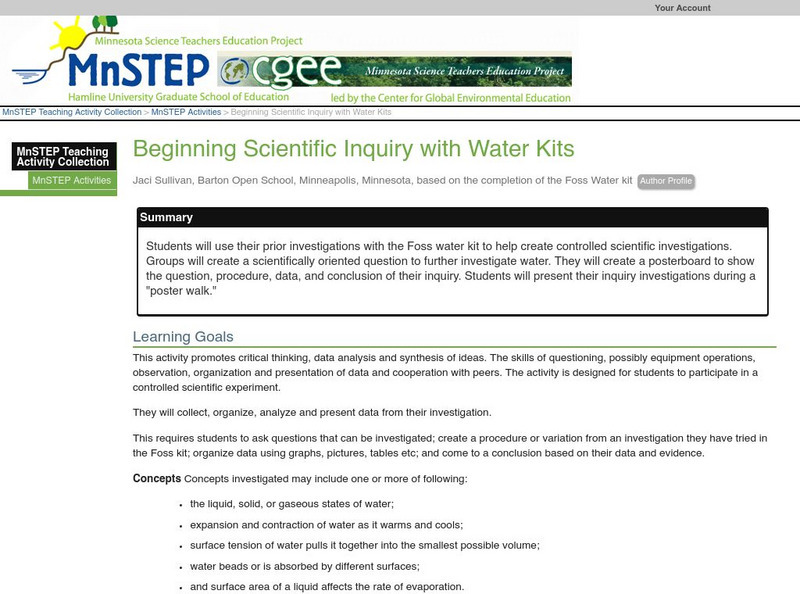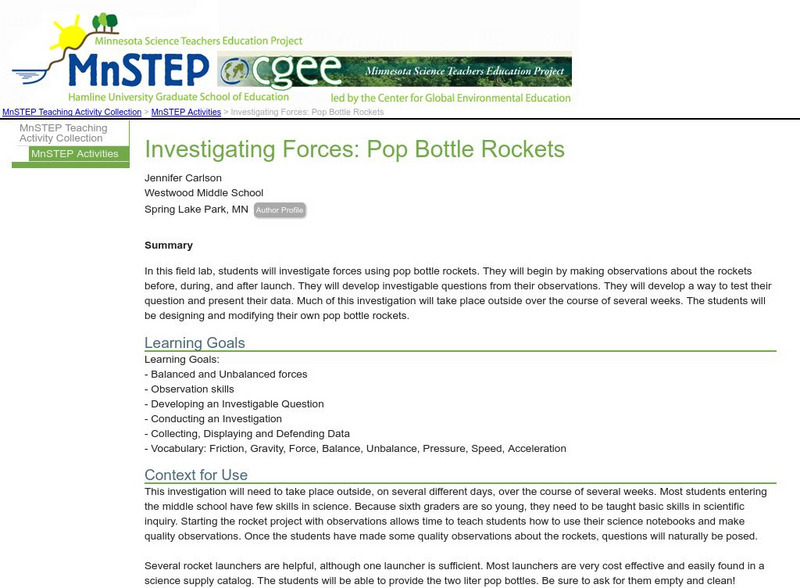Hi, what do you want to do?
Curated OER
2D Kinematics w/ String Racers
Students calculate the speed of string racers. In this physics instructional activity, students measure the time in several trials and get the average. They graph their results using a spreadsheet.
Curated OER
I Have the Solution!
Students explain how to make solutions with specific concentration. In this chemistry lesson plan, students differentiate acids and bases. They calculate molarity of solutions.
Curated OER
On the Surface
Students draw and label the 15 major rivers in Texas. They then draw and label another map with the major lakes and reservioirs of Texas. Students use the maps and locate and label the location of the following major Texas cities:...
Curated OER
Surface Water Supplies And The Texas Settlements
Learners engage in a lesson that is concerned with the allocation and finding of water resources. The location of different settlement areas is considered as one looks how the water is distributed. They map some of the early Spanish and...
Curated OER
Polar Bear Cubs and ME
Students visit the following web site to find out the birth weights and lengths of polar bear cubs- Ask Jeeves for Kids. They then enter the information found at this site relating to the birth length and weight of polar bear cubs into a...
Curated OER
Virial Theorem Lesson
Ninth graders describe how equilibrium can occur as the balance of two effects. They model the stability of elliptical galaxies based on how fast stars within the galaxy are moving.
Curated OER
Collisions Lesson
Tenth graders explore the role that collisions and near collisions of galaxies play in determining the shape of galaxies. They model the collision of disk shaped and spherically shaped galaxies.
Curated OER
Discovering Science with Lewis & Clark
Learners photograph plants and contribute their pictures to a class powerpoin on plant variety.
Curated OER
Ions in the Environment
Learners explain the importance of the five main biogeochemical cycles. In this chemistry lesson, students discuss how ions are transported in the environment. They design an experiment to collect data on eutrophication.
Curated OER
Don’t be a Stoic about Stoichiometry
Pupils review balancing chemical equations. In this chemistry lesson plan, students calculate moles of an unknown substance based on stoichiometric relationships in the balanced equation. They cite applications of stoichiometry in...
Curated OER
Blood Business
Students identify the different kinds of blood. In this biology lesson, students investigate the antigens, agglutinins and Rh factor using their own blood. They use Punnett squares to predict blood type of offspring.
Curated OER
The Importance of Water
Students explore the importance of water. They discuss why water is important and students design an experiment that evaluates the water quality and methods of improving water quality. Students perform testing and report their findings.
Curated OER
Cloning and Related Issues
Eighth graders research information on cloning and the surrounding issues online. They analyze the issues surrounding cloning and present their point of view with supporting details in a Powerpoint presentation.
Curated OER
Paleoindian Hunter
Sixth graders utilize their prior knowledge of the Woolly Mammoth to hypothesize what life was like for the Paleoindians. They write a story about a day in the life of a Paleoindian hunter.
Curated OER
Circuit Boards
Students explore circuit boards. They determine that a complete circuit is needed to light the bulbs, experiment with the boards to develop strategies for finding where the hidden connections are, and develop strategies that can be used...
Curated OER
Quarter Coin Cookies
Students study the historical figures and symbols of U.S.
patriotism depicted on the penny, nickel, dime, and quarter coins. They explore the processes involved in making coins, and how metals canchange in consistency from the...
Curated OER
What Does a Quarter Weigh?
Young scholars study the historical figures and symbols of U.S.
patriotism depicted on the penny, nickel, dime, and quarter coins. They
create a balance scale from common materials to measure the approximate weight
of a quarter.
Curated OER
Robot Turning Lab
Pupils design a robot that can turn 90 degrees. In this robotics lesson plan, students explain the applications of their invention. They present their design in class.
Curated OER
Robot Labyrinth
Students design a flowchart for their robotic program. For this physics lesson, students construct a robot that can navigate certain obstacles. They present their program and robots in class.
Curated OER
Sensor Challenge
Students develop a pseudo code flowchart for their robotic program. In this physics lesson, students construct a robot that can navigate through certain obstacles. They test their robot and present them to class.
Curated OER
Robot Olympics
Students design a robot based on given requirements. In this technology instructional activity, student test whether their robots can perform certain tasks. They present and discuss their program design.
Science Education Resource Center at Carleton College
Serc: Beginning Scientific Inquiry With Water Kits
Students will use their prior investigations with the Foss water kit to help create controlled scientific investigations. Groups will create a scientifically oriented question to further investigate water. They will create a posterboard...
BSCS Science Learning
Bscs: Asking and Answering Questions With Data
This inquiry is intended to provide learners with practice developing investigable questions that need data, and specifically large datasets, to be answered. Click the teacher resources link for teaching guides and student handouts.
Science Education Resource Center at Carleton College
Serc: Investigating Forces: Pop Bottle Rockets
In this lab, students will work on scientific inquiry skills: observation, developing questions, conducting an experiment, and collecting data. They will investigate forces using pop bottle rockets that they have designed.




























